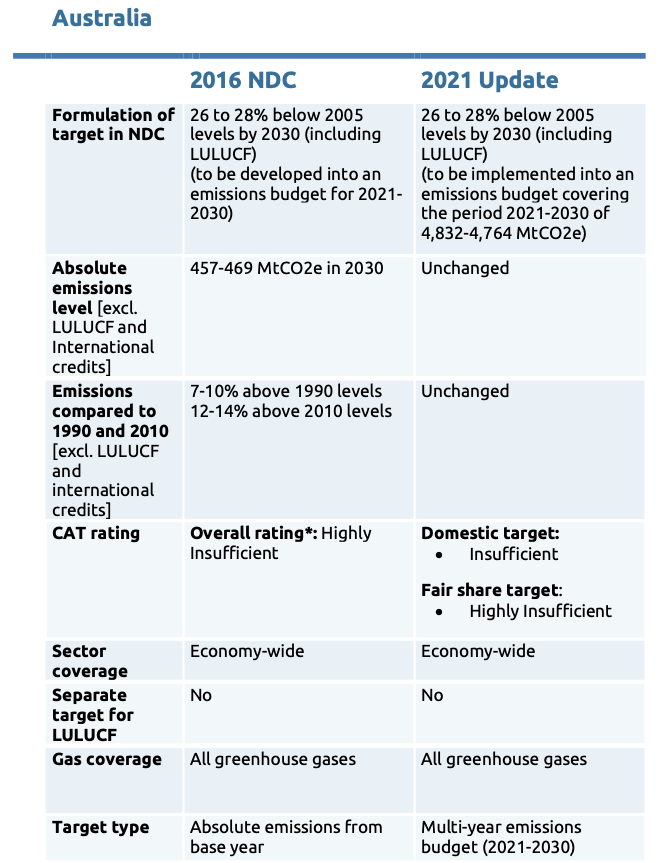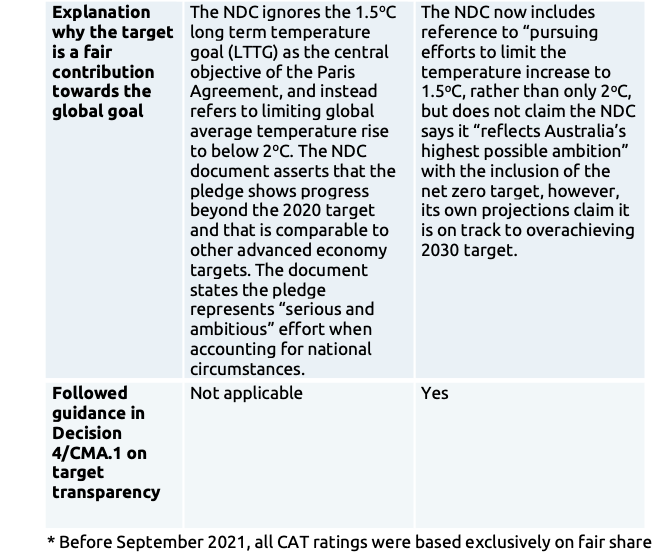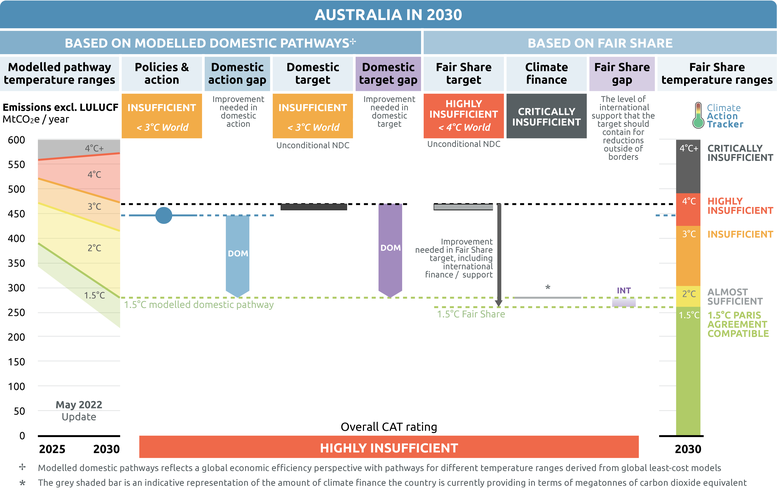Targets
Target Overview
In October 2021, Australia submitted an updated NDC, in which it recommunicated an unchanged 2030 target that it first submitted in 2015: a 26–28% reduction of greenhouse gas emissions by 2030 below 2005 levels, including LULUCF. This target covers all sectors. CAT excludes emissions from land use, land use change and forestry from this target, resulting in 457-469 MtCO2e in 2030. The resubmission includes a claim that Australia will exceed this target by up to 9%.
In October 2021, Australia released a long-term emission reduction plan for achieving net zero emissions by 2050, also submitted as a Long-Term Strategy (LTS) to the UNFCCC. However, the scenarios presented in the strategy only reduce emissions by 66% to 85% from 2005 emissions levels, so will not reach net zero.

NDC Updates
Australia submitted an updated NDC with a submission to the UNFCCC in October 2021, without an improvement in ambition.
Australia’s updated NDC claims that Australia will “overachieve” the target by up to 9% based on government emissions projections. The updated NDC says the lower projections are the result of new technology-focused emission reduction measures in the 2020-2021 federal budget and, the uptake of renewables and latest forecasts.
It bears repeating that Australia’s claim that it will overachieve its 2030 targets is not equivalent to submitting a stronger target to which it would agree to be bound.
Comparison table


Analysis of earlier NDC developments:
CAT rating of targets

NDC description
Australia has a 2030 NDC emissions reduction target of 26–28% below 2005 levels by 2030, including LULUCF and using Global Warming Potential (GWP) values from the IPCC’s Fifth Assessment Report (AR5).
Analysis of the effect of the NDC on likely fossil fuel and industrial GHG emissions is made difficult by the fact that the NDC target includes LULUCF emissions, which have been substantial in the past and fluctuate significantly. See the assumptions section for further details.
The target equates to a 11 to 13% reduction below 2005 emissions levels by 2030 when LULUCF is excluded, or an absolute emissions level of 465 to 478 MtCO2e based on AR5 values.
When covered to AR4 values (the CAT standard), the absolute emissions level in 2030 would be 457 to 469 MtCO2e (excl. LULUCF).
The updated NDC states Australia is on track to “meet and beat” its target without relying on Kyoto carryover credits (“past overachievement”), though the updated NDC does not rule out using carryover credits in the future. A number of other countries with similar carryovers have explicitly rejected such a move (OECD, 2019). It is neither legitimate nor defensible under the Paris Agreement (Climate Analytics, 2019c). Carryover would significantly lower the actual emissions reductions to 17–18% below 2005 levels by 2030 (including LULUCF) (Climate Analytics, 2019c). The Australian government has also indicated it supports the use of international units in principle (Australian Government, 2017, p. 41ff), which would further reduce domestic emissions reductions.
The CAT rates Australia’s NDC target as “Insufficient” when compared to the level of reductions needed within it borders (which we refer to as its “domestic target”) and as “Highly Insufficient” when compared to its fair share emissions allocation (which we refer to as its “fair share target”).
The CAT rates Australia’s domestic 2030 climate target as “Insufficient” when compared with modelled domestic emissions pathways. All countries need to rapidly reduce their emissions collectively to reach global net zero emissions and achieve the 1.5°C temperature limit of the Paris Agreement. Australia’s NDC is higher than the 1.5°C modelled domestic pathway and as such, Australia has a domestic gap between its target and a Paris Compatible pathway.
The CAT graph outlines Australia’s current NDC target excluding LULUCF, which is far off a 1.5°C compatible domestic emissions pathway. In fact, the NDC target falls between domestic pathway ranges consistent with 2°C and 3°C of warming: if all countries were to follow Australia’s approach, warming would reach over 2°C and up to 3°C.
Australia had an opportunity to improve the ambition of its NDC, but the government reiterated the same target to the UNFCCC. The “Insufficient” rating indicates that Australia’s domestic target in 2030 needs substantial improvements to be consistent with the Paris Agreement’s 1.5°C temperature limit. The current NDC is equivalent to 11-13%[1] below 2005 levels by 2030 including LULUCF. To improve its rating, Australia would need to resubmit its NDC with a more ambitious target compatible with the 1.5°C temperature limit.
[1] Based on emissions levels between 465 and 478 MtCO2e (AR5)
We rate Australia’s 2030 emissions reduction target as “Highly insufficient” when compared with its fair-share emissions allocation. The “Highly insufficient” rating indicates that Australia’s fair share target in 2030 is not at all consistent with the Paris Agreement’s 1.5°C temperature limit. Australia’s target is not in line with any interpretation of a fair approach to meeting the Paris Agreement’s 1.5°C limit and need substantial improvements. Some of these improvements should be made to the domestic emissions target itself, others could come in the form of additional financial support for emissions reductions in developing countries. If all countries were to follow Australia’s approach, warming could reach over 3°C and up to 4°C.
Australia’s international climate finance is rated “Critically insufficient” (see below) and is not enough to improve Australia’s fair share rating.

Australia’s international public climate finance contributions are rated “Critically insufficient”. Australia has committed to increase its climate finance but contributions to date have been very low compared to its fair share. To improve its rating, Australia needs to stop funding fossil fuels overseas and increase the level of its international climate finance.
Australia has committed AUD 1bn to climate finance (both mitigation and adaptation) over the period of 2015-2020 (Gayfer et al., 2018). Most of the finance is disbursed through multilateral finance, particularly compared with other OECD countries, and focuses on adaptation projects (Gayfer et al., 2018). Overall yearly contributions have slightly decreased since before Paris. The trend is more significant when only projects where climate is a principal component are considered (OECD, 2018). The Federal Government withdrew from the Green Climate Fund in 2019 and declined to put funds into its replenishment, and the situation has not changed (Mathiesen, 2019). A clear and sustained increase in international climate mitigation finance is fundamental in the period post-2020.
Australia remains committed to the USD 100bn a year goal in climate finance for developing countries through 2025. However, the USD 100bn goal, in itself, is insufficient in the period post-2020. Australia has committed to increasing its international climate finance to AUD 2bn over five years (2021-2025), for both mitigation and adaptation projects, up from a previous commitment to increasing funding to AUD 1.5bn over the same period (Australian Government, 2020e; UK Government, 2021b) . This level of financial contributions would not be enough to improve Australia’s CAT climate finance rating.
The biggest four Australian private banks have committed to stop funding coal thermal projects abroad (S&P Global, 2020). The government has not made such commitments. Concerns remain about continued support for fossil fuel projects in the Pacific region by Export Finance Australia, a commonwealth company (Market Forces, 2021). Australia has been described as “out of step” as the G7 stops international coal finance and calls for a phase out of fossil fuel subsidies while Australia hedges its future on a gas-fired recovery (SBS News, 2021). At COP26, Australia failed to commit to ending new direct public support for the international fossil fuel energy sector, contrary to the UK, USA, New Zealand and others (UK Government, 2021a).
Note: The CAT current contributions and trend ratings are based on OECD data which is released mid-year. The scores are based on data to 2019 (the latest year) and will be updated in due course.
Net zero and other long-term targets
Australia has submitted a long-term emissions reduction plan for achieving net zero emissions by 2050, also submitted as a Long-Term Strategy (LTS) to the UNFCCC in October 2021. However the scenarios presented in the strategy only reduce emissions by 66% to 85% from 2005 emissions levels. The plan relies on carbon offsets, global technology trends and unknown “technology breakthroughs”, without presenting any new policies (DISER, 2021e).
The government states in this planning document that its net zero by 2050 commitment, as with the 2030 NDC target, will not be legislated into law (DISER, 2021e). Instead, the government claims that it will, through the existing Technology Investment Roadmap, guide AUD 20bn of public funding towards the following priority low emissions technologies: clean hydrogen, ultralow-cost solar, energy storage, low emissions steel, CCS, and soil carbon. Overall, the LTS relies heavily on the future development of “low-emissions technology” not proven at scale such as CCS, along with land use reductions and international offsets, with no plans to phase out coal, curb fossil fuel exports, nor hold heavy polluters accountable.
In contrast, the reality on the ground at the state level, in public opinion, across the business sectors, and research organisations is very different. All states (including the Northern Territory and the ACT) now have either aspirational or legislated zero-emissions targets, and some have strong renewable energy targets as well as green/renewable energy hydrogen strategies in place.
Limiting temperature to 1.5°C is still possible with effective political action in place (Hare, Schleussner, et al., 2021). However, for Australia, this would require effort across all sectors to achieve at least a 66% reduction from 2005 levels by 2030 (including LULUCF) (Climate Analytics, 2021).
Further analysis of Australia’s net zero emissions can be found here.
Further analysis
Latest publications
Stay informed
Subscribe to our newsletter






